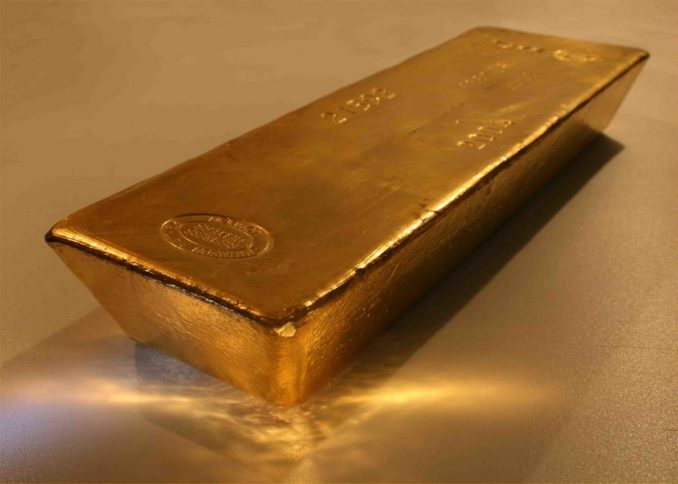
Bullion Vault – Licence CC BY-ND 2.0
At the end of September, a very interesting story made the rounds in the media and caught my attention. Apparently, the US big box giant Costco added one rather surprising product to its range and it proved immensely popular. Next to humongous multipacks of cereal, buckets of peanut butter, mattresses and air fryers, customers were offered the opportunity to throw a gold bar in their carts as well.
Selling like hotcakes
According to a recent CBS report: “The discount retailer said this week it has started selling 1-ounce bars of gold, but that demand is so strong it can’t keep them in stock even with a limit of two bars per member. The company is selling two types of bars: a 1-ounce gold PAMP Suisse Lady Fortuna Veriscan bar, which bears the imprint of a silhouette of the goddess of fortune with a cornucopia, and a 1-ounce bar from South Africa’s Rand Refinery, stamped with an elephant design. Both bars are about half an inch long. The PAMP Suisse bar is registered and comes with a digital certificate that can be accessed with a QR code, while the Rand bars come with their own serial numbers.”
Costco’s decision to include physical gold in its offering quickly proved to be welcomed by shoppers, with an unexpected enthusiasm. “I’ve gotten a couple of calls that people have seen online that we’ve been selling one ounce gold bars,” said Costco Chief Financial Officer Richard Galanti on an investor call this week. “Yes, but when we load them on the site, they’re typically gone within a few hours and we limit two per member.”
The move allowed ordinary people, many of whom likely never owned precious metals before, to invest in gold in a simple, direct and straightforward way. Like most savers, not just in the US but in Europe too, these first-time gold buyers very likely believed that precious metals investments were not for them, that they were reserved for the “1 percenters” or for investors with experience and access to the finance industry.
That’s a very dangerous, and unfortunately very common, misconception that I habitually encounter myself in my professional and social life. Too many hardworking, responsible people that wish to protect their savings from inflation and from the State’s legal, fiscal and regulatory unpredictability miss the opportunity presented by physical precious metals just because they assume that the investment process would be too complicated, too intimidating or simply that they would not be able to afford the minimums set by precious metals dealers.
Precious metals for everyone
While it is true that storage fees, the required minimum investments and other terms set by some companies can be prohibitive for many people, there is a wide range of options to choose from and there’s no shortage of solid, reliable and efficient solutions for those that are willing to allocate smaller amounts.
The important thing about investing in physical metals is not how much you own, it is the fact that you do own at least some. Physical gold and silver act as a stabiliser, a shield and a safe haven, and they perform those roles irrespective of the total amount invested. As long as the allocation is around 5-10% of one’s assets, it doesn’t really matter if the position is in the millions or simply a couple of tiny bars. It is all relative to the individual investor, their circumstances and their specific needs.
Having access to this kind of protection should never be seen as an exclusive privilege for the ultra rich. To the contrary, it can be argued that it is the ordinary saver that needs it more and can benefit from it in a much more practical and meaningful way. And judging by the reaction to Costco’s move, it would certainly appear that the wider public clearly understands that too.
Inflation has definitely pushed many people to rethink and reevaluate their financial plans and decisions. It made it crystal clear, even to those that never considered this threat before, that their paycheques and the money sitting in their accounts is rapidly losing value, that it will continue to do so and the only way to prevent that is to exchange these pieces of paper for something of actual, real value. After all, over the past five years, the price of gold has soared 57%.
The banking crisis in the US and in Europe also helped drive the point home that the current system cannot be relied upon and that any responsible saver should have a “plan B” in place that does not depend on banks. The war on cash has had a big impact too. As limitations and restrictions keep piling up and increasingly stifle individual financial sovereignty, more and more people come to the conclusion that they need to reclaim their independence and preserve their freedom of choice, and that they have to act now, while they still can. The simplest first step to reduce one’s exposure to these risks is to invest in physical precious metals, no matter how small that initial investment is.
This article has been published in the Newsroom of pro aurum, the leading precious metals company in Europe with an independent subsidiary in Switzerland.
This work is licensed under a Creative Commons Attribution 4.0 International License. Therefore please feel free to share.


